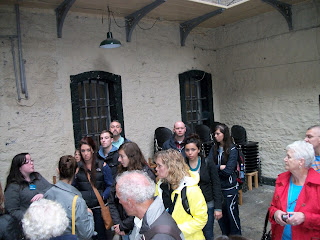For a tour of course :-)
When it was first built in 1796, Kilmainham Gaol was called the 'New Gaol' to distinguish it from the old gaol it was intended to replace - a noisome dungeon, just a few hundred yards from the present site. It was officially called the County of Dublin Gaol, and was originally run by the Grand Jury for County Dublin.
When the Gaol was first built, public hangings took place at the front of the Gaol. However, from the 1820s onward very few hangings, public or private, took place at Kilmainham. A small hanging cell was built in the gaol in 1891. It is located on the first floor, between the West Wing and the East Wing.
There was no segregation of prisoners; men, women and children were incarcerated up to 5 in each cell, with only a single candle for light and heat, most of their time was spent in the cold and the dark. The candle had to last the prisoner for one week. Its cells were roughly 28 meters squared.
Children were sometimes arrested for petty theft, the youngest said to be a five year-old child, while many of the adult prisoners were deported to Australia.
At Kilmainham the poor conditions in which women prisoners were kept provided the spur for the next stage of development. Remarkably, for an age that prided itself on a protective attitude for the 'weaker sex', the conditions for women prisoners were persistently worse than for men. As early as his 1809 report the Inspector had observed that male prisoners were supplied with iron bedsteads while females 'lay on straw on the flags in the cells and common halls.' Half a century later there was little improvement. The women's section, located in the west wing, remained overcrowded.
Edmund Wellisha, the head guard at the prison, was convicted of undernourishing prisoners in support of the rebellion.

















No comments:
Post a Comment